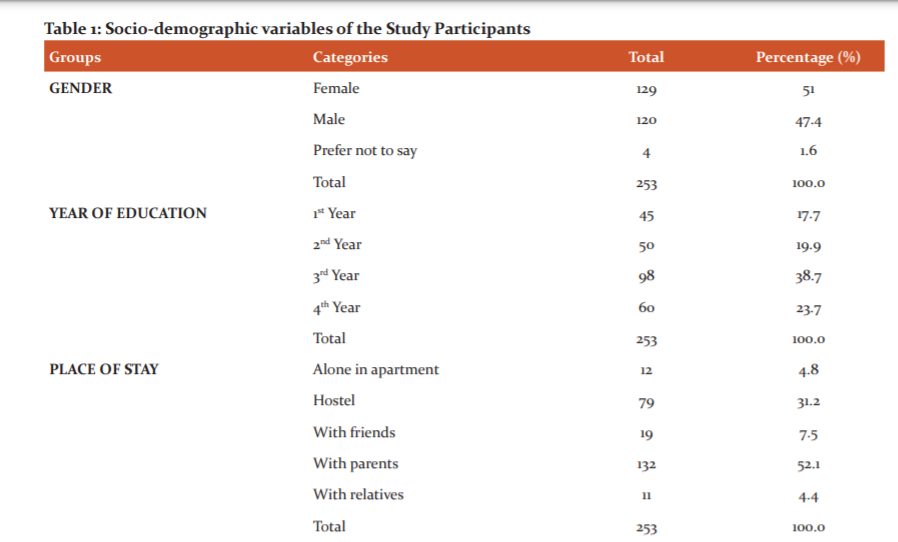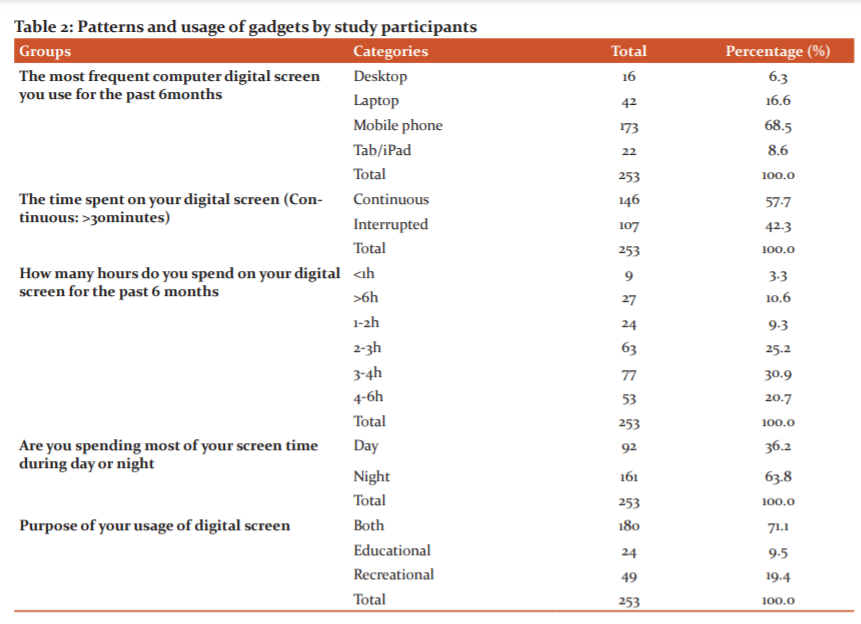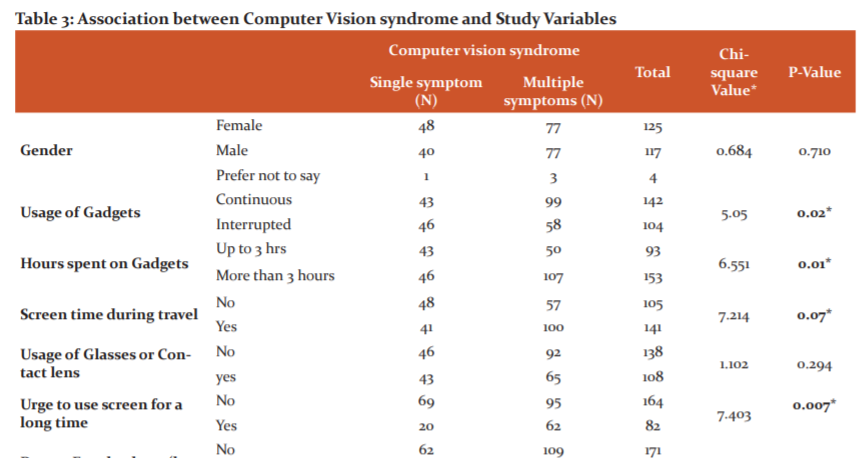IJCRR - 13(6), March, 2021
Pages: 51-55
Date of Publication: 20-Mar-2021
Print Article
Download XML Download PDF
A Study on Single versus Multiple Symptoms of Computer Vision Syndrome (CVS) among Engineering Students in Kancheepuram District, Tamil Nadu
Author: Sanjay Selvaraj, Dinesh Kumar Ganesan, Timsi Jain
Category: Healthcare
Abstract:Introduction: Advancement in technology has led to prolong and rampant computer usage which in turn has led to many health problems, among which problems related to eyes are very prominent and one among them is Computer Vision Syndrome (CVS). Objectives: The present study was conducted to assess the prevalence and associated risk factors of Computer Vision Syn�drome among the Computer Science students of an Engineering College. Methods: A cross-sectional study was conducted among undergraduate engineering college students of a University situated in Kancheepuram. The participants were surveyed using a pre-tested structured questionnaire through google forms. In this, factors affecting single and multiple symptoms of CVS were compared. Results: A total of 253 students were included in the study based on the In the population studied,129/253 (51%) were females, 120/253(47.4%) were males The use rate of mobile phone174/253 (68.5%) was higher and the majority153/253 (60.4%) of their screen time were for more than 3 hours. The prevalence was found to be 97.2% among the students. The present study showed that almost all the students complained of any one of the symptoms of CVS while using a computer/gadget. Conclusion: The use of computers has become universal in higher education institutions that too in this pandemic situation, the subject of the prevention of CVS and associated discomfort should be made part of the curriculum in higher institutions.
Keywords: Computer Vision Syndrome (CVS), Digital screen, Engineering students, Dry eye, Screen time, Gadget use
Full Text:
Introduction
The introduction of the computer has brought a phenomenal change in our daily lives. Almost all institutions, workplaces, and homes are using computers regularly which has its advantages as well as drawbacks.1 The term Computer Vision Syndrome (CVS) is applied to a set of different symptoms for those who use computers or smartphones for a long-time during day and night. The Prevalence of CVS ranges from 64% to 90% among computer users. Nearly 60 million people suffer from CVS globally. A million new cases of CVS occur each year. Millions of people including children, college students are using computers for prolonged hours.2 Symptoms of CVS are dry and irritated, eye strain/fatigue, blurred vision, red eyes, burning eyes, excessive tearing, double vision, headache, light/glare sensitivity, slowness in changing focus and changes in colour perception.3 Nowadays, a large number of university students are using computers for studies and research work. Also, computers are used by them for seeing movies, playing computer games, and online chatting. The discomfort associated with computer usage has not yet been proven to result in permanent damage but may cause a reduction in work accuracy.4 Computer Vision Syndrome affects mental and physical well-being and impairs productivity. Computer Vision Syndrome can be virtually eliminated by taking a few simple, inexpensive precautions.5CVS is an increasing health issue unnoticed by many which affects the lives of many especially students and through our study, we try to find out more about this issue. The objective of this study is to determine the prevalence of CVS and its associated risk factors (single vs multiple) among undergraduate computer science engineering students.
Materials AND Methods
A cross-sectional study was conducted among students in an Engineering college in South India. The Study duration was for 3 months(February-April 2020) and we included the Computer science branch of Engineering students in our study. The sample size was estimated using the Prevalence of 80.1% according to a study conducted in Chennai 1 and by that estimate, we required around 250 samples. We were able to collect 253 samples. Ethical approval (SMC/IEC/2020/03/410) was sought from the IRB of Saveetha Medical College and Hospital.
Study Tool
The study tool was a Pre-tested, semi-structured questionnaire that included variables like socio-demographic profile, questions on screen time, symptoms of CVS, type of gadget used. The study participants were instructed to mark any eye and other related symptoms experienced during the usage of gadgets.
Diagnostic Criteria of Computer Vision Syndrome
Students experiencing at least one of the CVS related symptom like redness of eyes, burning sensation, eye strain, headache, blurred vision, dry eye, backache, and neck or shoulder pain 5
Data Collection
The questionnaire prepared was sent as Google forms to representatives of each class of all semesters of the Computer Science Engineering department through WhatsApp. They were encouraged to fill out the form in their spare time and submit it within a stipulated period.
Data Analysis
The responses received were compiled in the Microsoft Excel sheet and analyzed using SPSS software. Data were expressed as proportions and chi-square was used to measure the association between the variables. A p-value of less than 0.05 was considered to be statistically significant.
RESULTS
Socio-demographic variables of the Study Participants
A total of 253 students were included in the study based on the In the population studied, Majority i.e. 129/253 (51%) were females, 98/253 (38.7%) were from 3rd Year, 132/253 (52.1%) were staying with their parents and 83/253 (32.8%) travel to college by College Bus (Table 1).
Patterns and usage of gadgets by study participants
The majority of study subjects i.e. 173/253 (68.5%) were using Mobile phones as frequent computer digital screen followed by 42/253 (16.6%) were Laptop, 142/253 (57.7%) were using continuously the digital screen without interruption for more than 30 minutes, 77/253 (30.9%) were using a digital screen for around 3-4 Hours daily, 161/253 (63.8%) were using the digital screen during Nighttime and 180/253 (71.1%) the purpose of use of computer digital screen for both educational and recreational purposes, separately 49/253 (19.4%) were using it only for recreationally and 24/253 (9.5%) were used only for educational purposes ( Table 2).
Single versus Multiple CVS symptoms and its affecting factors
The prevalence of Computer vision syndrome in our study 97% is out of which 89/253 have a single symptom of CVS, while 157/253 are having multiple symptoms of CVS. There is an equal distribution of males and females with multiple symptoms of CVS. The majority (107) of those with multiple CVS symptoms use gadgets for more than 3 hours. The difference when compared to whose use gadgets less than 3 hours per day is statistically significant (p<0.05). Multiple CVS symptoms are found more in persons who have screen time during travel when compared to those who don’t. but on applying the Chi-square test, this difference was not found to be statistically. Among those with Multiple CVS symptoms, many have reported that they use the Screen continuously (more than 30 mins). The difference when compared to those that have only a single symptom, on applying chi-square was found to be statistically significant (p=0.02). Multiple symptoms of CVS are more in persons who don’t use a glass or contact lens when compared to those who use it, but this difference is not statistically significant (Table 3).
DISCUSSION
This study was conducted among 253 undergraduate computer science engineering college students and the prevalence of CVS in the study population was found to be 97.2%. This is in line with the study by Ghufran et al., who reported a prevalence of 95% among undergraduate medical students in Saudi Arabia.6 Another high prevalence of 89.9% was reported by a study by Reddy et al. among different university students.7 In contrast,a prevalence of 55.5% was reported among Professional College Students of Agartala 8 and a study among computer office workers in Srilankareported a prevalence of 67%.3 As the study population was Computer science students, the screen time is naturally high which has led to this highly reported proportion of CVS. Concerning gender, females were observed to have more risk of CVS than males. Studies in Sri Lanka, India, and the United Arab Emirates also support the significantly high CVS prevalence among female computer workers, with significantly higher headache and blurred vision incidence.1,3,9 In contrast, males were found to have a higher risk of redness, burning sensation, blurred vision, and dry eyes among medical and engineering students in India.1 No significant associations were found between the year of engineering and the age with CVS.
The present study found that an increase in the number of hours spent on gadgets increases the risk of CVS significantly. Students who spend less than 3 hours per day on gadgets daily reported only a single symptom. Rahman et al. in their study reported that those respondents who used computers for more than 5 hours per day were at higher risk of developing CVS.10 The duration of computer work is directly related to eye symptoms; longer duration leads to result in long-lasting complaints even after the work is finished.
In our study, the duration of gadget use (mobile phone, iPad/tablet, computer, and laptop) time is found to be directly associated with symptoms of computer vision syndrome. Computer usage time of more than 3 hours (180 minutes) is found to be significantly associated with visual symptoms. These findings were consistent with a study conducted in Nigeria which described a link between duration of gadget use and development of symptoms.11 Students who used their gadgets during their travel have reported having more than one symptom of CVS. In our study, the participants who use gadgets with interruption (break after at least 30 minutes of gadget use) experience a single symptom, and those who use continuously (for more than 30 minutes) experience multiple symptoms of CVS, however, there was no significant association between frequency of breaks and relief of symptoms. It is recommended to follow the rule of 20/20/20 to reduce the symptoms of computer vision. i.eone should sit 20 feet away, take 20 min break after 20 minutes of computer use.12
We also highlighted this as a public health issue and identified the risk factors associated with computer vision syndrome. However, there are certain limitations to our study. Since it was a cross-sectional study it limits the establishment of the causal association between identified risk factors and CVS. It was a single centred study and symptoms of CVS were self-reported.
Conclusion
The present study shows that almost all computer science students are affected by Computer Vision Syndrome (CVS) that is they possess at least one symptom of CVS. Even though the use of computers/gadgets had not yet proven to cause any permanent damage to the eyes, but studies have proven that temporary discomfort reduces the efficiency of work and thereby productivity. In the future, prospective studies with follow-ups should be designed to establish the causal inference.As the use of computers had become universal in higher education institutions that too in this pandemic situation, the subject of the prevention of CVS and associated discomfort should be made part of the curriculum in higher institutions. This should be further supplemented by regular use of protective wear and ergonomic correction. A multi-prong strategy is required to tackle this growing situation.
Disclosure of funding sources: Not applicable.
Financial disclosure: The author has no sources of funding or other financial disclosures concerning the above article.
Informed Consent: Proper Informed Consent was taken from all participants before initiation of the study and Confidentiality was maintained.
Declaration of Competing Interest: The authors declare that there are no conflicts of interest.
ACKNOWLEDGEMENT
The authors acknowledge the immense help received from the scholars whose articles are cited and included in references to this manuscript. The authors are also grateful to authors/ editors/publishers of all those articles, journals, and books from where the literature for this article has been reviewed and discussed.
Contribution of the Authors
(1) Conception and design of the study, acquisition, and entry of data (2) analysis and interpretation of data, manuscript writing (3) Drafting the article, revising it critically for important intellectual content & Proofreading.




References:
-
Logaraj M, Madhupriya V, Hegde SK. Computer vision syndrome and associated factors among medical and engineering students in Chennai. Ann Med Health Sci Res 2014;4(2):179-185.
-
Al Rashidi SH, Alhumaidan H. Computer vision syndrome prevalence, knowledge and associated factors among Saudi Arabia University Students: Is it a serious problem? Int J Health Sci (Qassim) 2017;11(5):17-19.
-
Ranasinghe P, Wathurapatha WS, Perera YS, Lamabadusuriya DA, Kulatunga S, Jayawardana N, et al. Computer vision syndrome among computer office workers in a developing country: an evaluation of prevalence and risk factors. BMC Res Notes 2016;9(1):150.
-
Assefa NL, Weldemichael DZ, Alemu HW, Anbesse DH. Prevalence and associated factors of computer vision syndrome among bank workers in Gondar City, northwest Ethiopia, 2015. Clin Opthalmol 2017;9:67-76.
-
Ranganatha SC, Jailkhani S. Prevalence and associated risk factors of computer vision syndrome among the computer science students of an engineering college of Bengaluru-a cross-sectional study. Galore Int J Health Sci Res 2019;4(3):10-15.
-
Abudawood GA, Ashi HM, Almarzouki NK. Computer Vision Syndrome among Undergraduate Medical Students at King Abdulaziz University, Jeddah, Saudi Arabia. J Ophthalmol 2020;2020: Article ID 2789376
-
Reddy SC, Low CK, Lim YP, Low LL, Martina F, Nursaleha MP. Computer vision syndrome: a study of knowledge and practices in university students. Nepalese J Ophthalmol 2013;5(2):161-168.
-
Das S, Das R, Kumar A. Computer vision syndrome and its risk factors among professional college students of Agartala: a cross-sectional study. Med Sci 2016;5(6):27-29.
-
Shantakumari N, Eldeeb R, Sreedharan J, Gopal K. Computer use and vision. related problems among university students in Ajman, United Arab Emirate. Ann Med Health Sci Res 2014;4(2):258-263.
-
Rahman ZA, Sandip S. Computer user: demographic and computer-related factors that predispose the user to get computer vision syndrome. Int J Bus Humanit Technol 2011;1(2):84-91.
-
Akinola Kayode E, Idowu BN, Gbenga OS. Prediction of an increase in eye problems, in Ijebu-ode and Ijebu north local government area of Ogun State in the nearest future as a result of spending much time on computer/smartphone. Int J Cur Res Rev 2014;6(16):35-40.
-
Noreen K, Batool Z, Fatima T, Zamir T. Prevalence of computer vision syndrome and its associated risk factors among undergraduate medical students of urban Karachi. Pak J Ophthalmol 2016;32(3):140-146.
|






 This work is licensed under a Creative Commons Attribution-NonCommercial 4.0 International License
This work is licensed under a Creative Commons Attribution-NonCommercial 4.0 International License